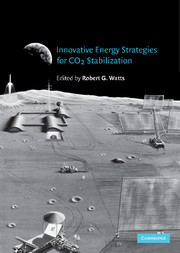Book contents
- Frontmatter
- Contents
- List of contributors
- 1 Concerns about Climate Change and Global Warming
- 2 Posing the Problem
- 3 Adaptive Strategies for Climate Change
- 4 Energy Efficiency: a Little Goes a Long Way
- 5 The Potential of Renewable Energy to Reduce Carbon Emissions
- 6 Carbonless Transportation and Energy Storage in Future Energy Systems
- 7 What Can Nuclear Power Accomplish to Reduce CO2 Emissions
- 8 Nuclear Fusion Energy
- 9 Energy Prosperity Within the Twenty-first Century and Beyond: Options and the Unique Roles of the Sun and the Moon
- 10 Geoengineering the Climate: History and Prospect
- Index
8 - Nuclear Fusion Energy
Published online by Cambridge University Press: 22 October 2009
- Frontmatter
- Contents
- List of contributors
- 1 Concerns about Climate Change and Global Warming
- 2 Posing the Problem
- 3 Adaptive Strategies for Climate Change
- 4 Energy Efficiency: a Little Goes a Long Way
- 5 The Potential of Renewable Energy to Reduce Carbon Emissions
- 6 Carbonless Transportation and Energy Storage in Future Energy Systems
- 7 What Can Nuclear Power Accomplish to Reduce CO2 Emissions
- 8 Nuclear Fusion Energy
- 9 Energy Prosperity Within the Twenty-first Century and Beyond: Options and the Unique Roles of the Sun and the Moon
- 10 Geoengineering the Climate: History and Prospect
- Index
Summary
Introduction
Fusion could become the energy source of choice early in the third millennium – it is a long-term, inexhaustible energy option that offers the possibility of generating power in an economically and environmentally attractive system, which is compact relative to renewable energy power plants, and does not emit carbon dioxide or other greenhouse gases. The small loss of mass when light nuclei fuse into heavier nuclei provides the source of energy. In one sense it is the only longterm option other than fission, since the sun, which is the source of all forms of renewable energy, is powered by fusion reactions. In this chapter, we will present our personal vision of fusion's potential, illustrated with examples of innovative concepts at an early stage of development, and grounded in the dramatic progress towards fusion energy demonstrated by the more traditional concepts.
Fusion occurs when two positively charged nuclei approach closely enough for the attractive short-range nuclear forces to overcome the repulsive Coulomb force. Getting two nuclei this close requires that they have a high energy or temperature of about ten thousand electron volts (10 keV ≈ 100 million Kelvin). (At temperatures above 0.01 keV, the atoms have such a high velocity that the electrons are knocked off by collisions. This results in the mixture of equal amounts of positively charged ions and negatively charged electrons that is known as a plasma.)
- Type
- Chapter
- Information
- Innovative Energy Strategies for CO2 Stabilization , pp. 325 - 344Publisher: Cambridge University PressPrint publication year: 2002



